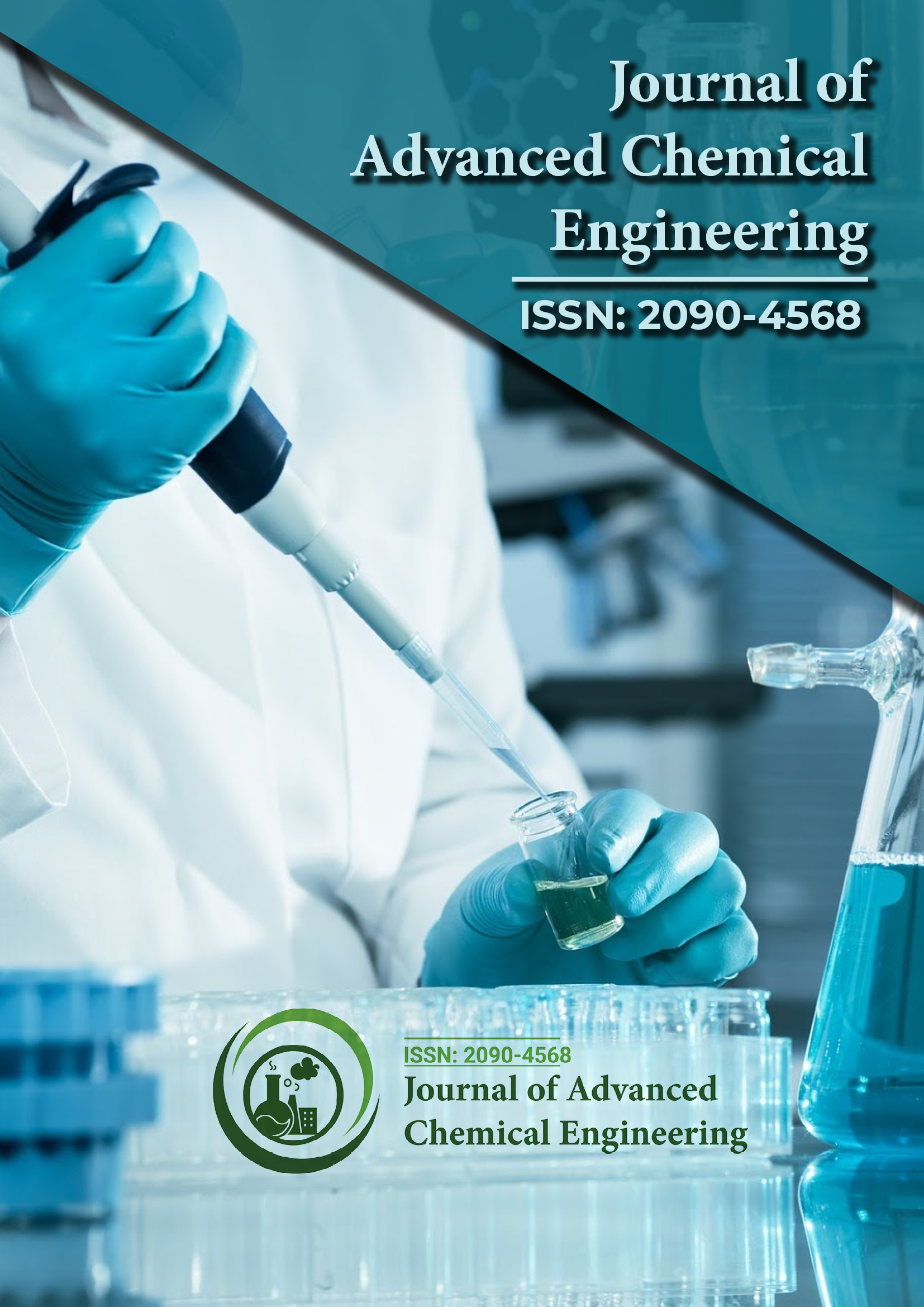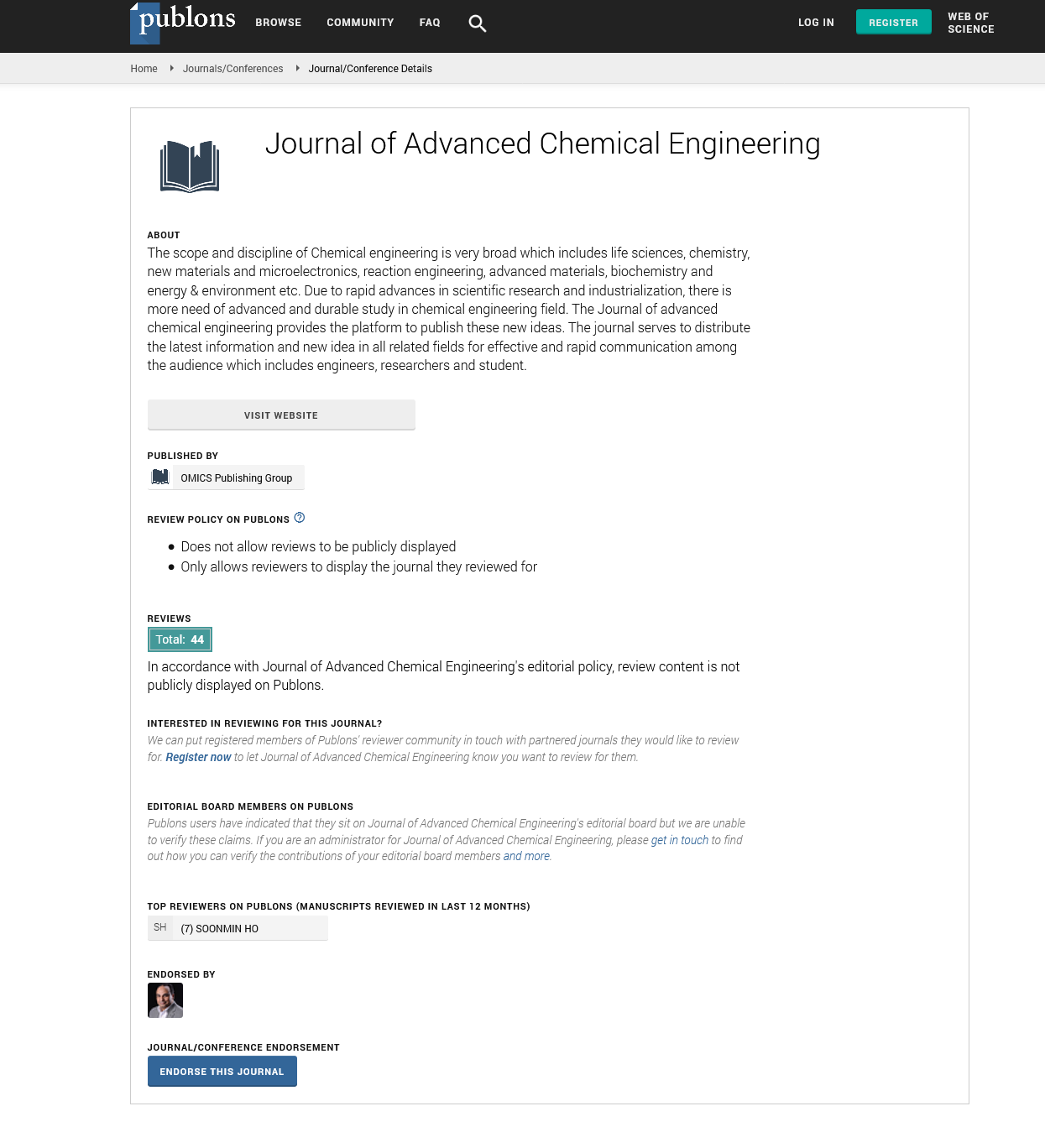Indexed In
- Open J Gate
- Genamics JournalSeek
- Smithers Rapra
- RefSeek
- Directory of Research Journal Indexing (DRJI)
- Hamdard University
- EBSCO A-Z
- OCLC- WorldCat
- Scholarsteer
- Publons
- Geneva Foundation for Medical Education and Research
- Google Scholar
Useful Links
Share This Page
Journal Flyer

Open Access Journals
- Agri and Aquaculture
- Biochemistry
- Bioinformatics & Systems Biology
- Business & Management
- Chemistry
- Clinical Sciences
- Engineering
- Food & Nutrition
- General Science
- Genetics & Molecular Biology
- Immunology & Microbiology
- Medical Sciences
- Neuroscience & Psychology
- Nursing & Health Care
- Pharmaceutical Sciences
Commentary - (2025) Volume 15, Issue 1
Thermochemical Water Splitting Using Metal Oxide Cycles: A Promising Pathway for Solar Hydrogen Production
Kenji Yamashita*Received: 03-Mar-2025, Manuscript No. ACE-25-29152; Editor assigned: 05-Mar-2025, Pre QC No. ACE-25-29152 (PQ); Reviewed: 19-Mar-2025, QC No. ACE-25-29152; Revised: 26-Mar-2025, Manuscript No. ACE-25-29152 (R); Published: 02-Apr-2025, DOI: 10.35248/2090-4568.25.15.356
Description
Hydrogen has long been considered a clean and sustainable energy carrier, capable of powering fuel cells and industrial processes with water as the only byproduct. However, the conventional production methods for hydrogen, primarily steam methane reforming and coal gasification, are highly carbonintensive and undermine its environmental benefits. An alternative method that has gained increasing interest in recent years is thermochemical water splitting, especially using metal oxide redox cycles driven by concentrated solar energy.
The thermochemical splitting of water involves multiple chemical reactions occurring in a cyclic manner at high temperatures. The net reaction is the decomposition of water into hydrogen and oxygen, but unlike direct electrolysis, the energy input comes from thermal energy, ideally sourced from the sun. Metal oxides play a crucial role in these cycles, undergoing reduction and oxidation reactions that enable the splitting of water molecules.
Among the many redox materials investigated, Cerium Oxide (CeO2) has emerged as a particularly promising candidate due to its rapid kinetics, oxygen storage capacity, and thermal stability. In a typical two-step cycle, cerium oxide is first thermally reduced at temperatures around 1500°C to release oxygen and form nonstoichiometric CeO2-δ. In the second step, the reduced oxide is reoxidized with water vapor at 800°C-1000°C, producing hydrogen and regenerating the original oxide. This cycle can be repeated numerous times with high efficiency and minimal degradation.
Other metal oxides such as ferrites (e.g., NiFe2O4, CoFe2O4) and perovskites have also shown considerable potential, particularly for their lower reduction temperatures and tunable properties through doping and structural modification. Perovskites, in particular, offer compositional flexibility that can be exploited to balance reduction and oxidation thermodynamics, optimizing the hydrogen yield.
The challenge lies not only in material selection but also in the reactor design and solar energy capture systems. The solar thermochemical reactors must be capable of withstanding extreme temperatures, ensuring uniform heat distribution, and maintaining rapid heat and mass transfer. Rotating cavity reactors, packed bed reactors, and fluidized bed configurations are currently under investigation, each with their own advantages in terms of scalability, heat utilization, and reactant flow dynamics.
To efficiently harness solar energy, Concentrated Solar Power (CSP) systems are employed using parabolic dishes, heliostats, or Fresnel lenses to focus sunlight onto the reactor. This approach achieves the high temperatures necessary for metal oxide reduction without reliance on fossil fuels. However, solar intermittency and variability pose significant challenges, requiring advanced thermal energy storage solutions. Materials like molten salts and ceramic heat sinks are being explored to provide buffer storage and maintain consistent operation during transient solar conditions.
Thermodynamic and kinetic modeling play a pivotal role in optimizing the performance of thermochemical cycles. Advanced computational tools are used to simulate the reaction pathways, heat flow, and species transport within the reactor. These models are validated through experimental trials and provide insights that guide reactor scaling and material improvement. Process integration studies have also shown that coupling thermochemical hydrogen production with downstream synthesis of ammonia or methanol can improve overall energy utilization and economic viability.
Despite the promise of thermochemical water splitting, there are still several barriers to large-scale deployment. The high operating temperatures necessitate the use of advanced materials for reactor construction, leading to higher initial capital costs. Additionally, ensuring the long-term stability and recyclability of metal oxides over hundreds of cycles is a critical area of ongoing research. Cost reduction through material innovation, process intensification, and mass production is essential for competitiveness with established hydrogen production methods.
Nevertheless, pilot plants around the world have demonstrated the feasibility of this approach. For instance, the HYDROSOL project in Europe successfully operated a solar-driven reactor for hydrogen production using ferrite-based materials. Similar initiatives in Japan, the United States, and Australia are pushing the boundaries of what is possible, advancing both the scientific understanding and practical application of solar thermochemical cycles.
In conclusion, thermochemical water splitting using metal oxide redox cycles represents a compelling and sustainable route for hydrogen production. It leverages abundant solar energy, avoids carbon emissions, and offers scalability for future energy needs. With continued advancements in material science, reactor engineering, and solar concentration technology, this approach is poised to play a significant role in the global transition toward a hydrogen economy.
Citation: Yamashita K (2025). Thermochemical Water Splitting Using Metal Oxide Cycles: A Promising Pathway for Solar Hydrogen Production. Adv Chem Eng. 15:356.
Copyright: © 2025 Yamashita K. This is an open-access article distributed under the terms of the Creative Commons Attribution License, which permits unrestricted use, distribution, and reproduction in any medium, provided the original author and source are credited.

